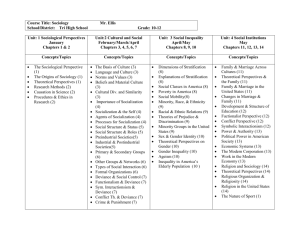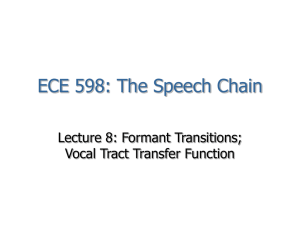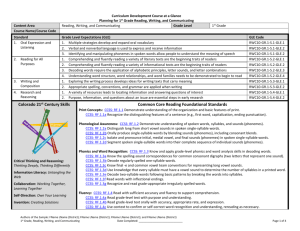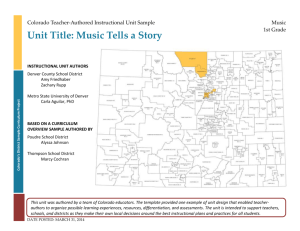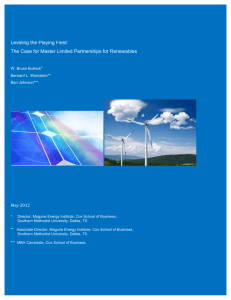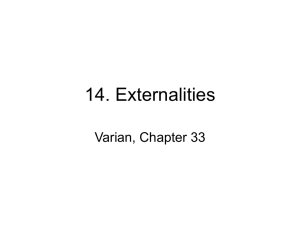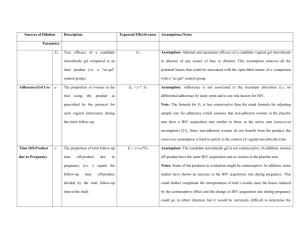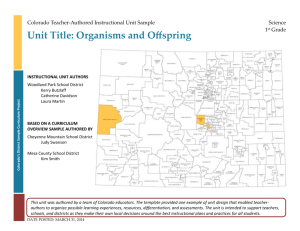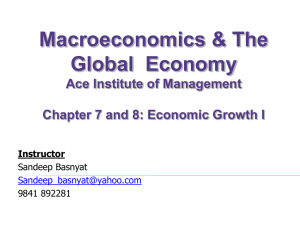Word - Colorado Department of Education
advertisement
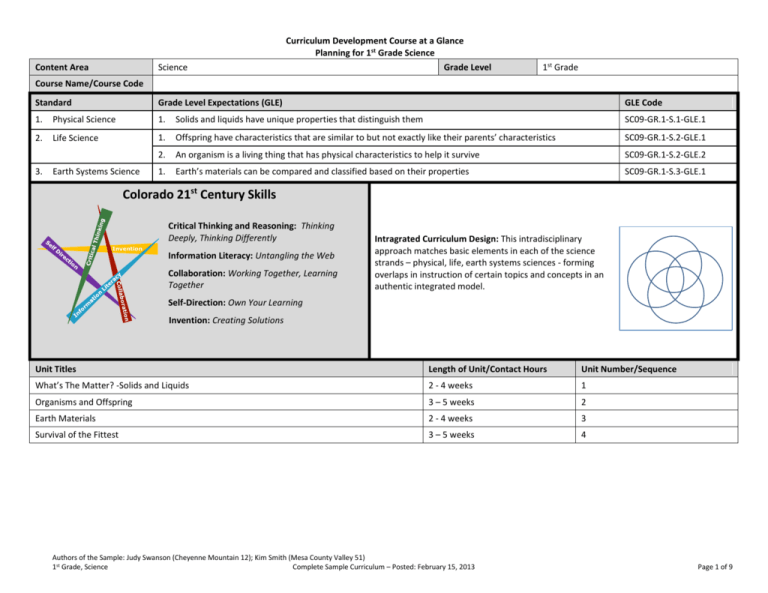
Content Area Science Curriculum Development Course at a Glance Planning for 1st Grade Science Grade Level 1st Grade Course Name/Course Code Standard Grade Level Expectations (GLE) GLE Code 1. Physical Science 1. Solids and liquids have unique properties that distinguish them SC09-GR.1-S.1-GLE.1 2. Life Science 1. Offspring have characteristics that are similar to but not exactly like their parents’ characteristics SC09-GR.1-S.2-GLE.1 2. An organism is a living thing that has physical characteristics to help it survive SC09-GR.1-S.2-GLE.2 1. Earth’s materials can be compared and classified based on their properties SC09-GR.1-S.3-GLE.1 3. Earth Systems Science Colorado 21st Century Skills Critical Thinking and Reasoning: Thinking Deeply, Thinking Differently Invention Information Literacy: Untangling the Web Collaboration: Working Together, Learning Together Intragrated Curriculum Design: This intradisciplinary approach matches basic elements in each of the science strands – physical, life, earth systems sciences - forming overlaps in instruction of certain topics and concepts in an authentic integrated model. Self-Direction: Own Your Learning Invention: Creating Solutions Unit Titles Length of Unit/Contact Hours Unit Number/Sequence What’s The Matter? -Solids and Liquids 2 - 4 weeks 1 Organisms and Offspring 3 – 5 weeks 2 Earth Materials 2 - 4 weeks 3 Survival of the Fittest 3 – 5 weeks 4 Authors of the Sample: Judy Swanson (Cheyenne Mountain 12); Kim Smith (Mesa County Valley 51) 1st Grade, Science Complete Sample Curriculum – Posted: February 15, 2013 Page 1 of 9 Curriculum Development Overview Unit Planning for 1st Grade Science Unit Title What’s the Matter? -Solids and Liquids Focusing Lens(es) Patterns Patterns find similarities and differences when comparing and contrasting the properties of solids and liquids. Inquiry Questions (EngagingDebatable): Unit Strands Physical Science Concepts properties, matter, patterns, compare and contrast Standards and Grade Level Expectations Addressed in this Unit Length of Unit 2-4 weeks SC09-GR.1-S.1-GLE.1 How are patterns detected when sorting solids and liquids? (SC09-GR.1-S.1-GLE.1;RA.2) Generalizations My students will Understand that… Guiding Questions Factual Conceptual Patterns in nature are often revealed by comparing and contrasting states of matter (SC09-GR.1-S.1-GLE.1-EO.c) Where would one find patterns in nature? Why is it important to find similarities and differences amongst matter? (SC09-GR.1-S.1-GLE.1-EO.a,b,c) States of matter possess unique properties which facilitates classification (SC09-GR.1-S.1-GLE.1-EO.a) What are the common properties of a solid? (SC09GR.1-S.1-GLE.1-EO.a; IQ.2,4) What are the common properties of a liquid? (SC09GR.1-S.1-GLE.1-EO.a; IQ.1,3) What is different about the properties of matter? (SC09GR.1-S.1-GLE.1-EO.a; IQ.1,2,3,4) How are the properties of matter identified? How can you prove if something is a solid? (SC09-GR.1S.1-GLE.1;IQ.2) How can you prove if something is a liquid? (SC09-GR.1S.1-GLE.1;IQ.1) Authors of the Sample: Judy Swanson (Cheyenne Mountain 12); Kim Smith (Mesa County Valley 51) 1st Grade, Science Complete Sample Curriculum – Posted: February 15, 2013 Page 2 of 9 Curriculum Development Overview Unit Planning for 1st Grade Science Critical Content: Key Skills: My students will Know… My students will be able to (Do)… The unique properties of solids and liquids (SC09-GR.1-S.1-GLE.1-EO.a) The similarities and differences of solids and liquids (SC09-GR.1-S.1-GLE.1-EO.b) The properties of solids and liquids in relation to the understanding of matter (SC09-GR.1-S.1-GLE.1; RA.1) The practical reasons for sorting solids and liquids (SC09-GR.1-S.1-GLE.1;RA.2) Observations as an important part of science (SC09-GR.1-S.1-GLE.1;N.2) Analyze and interpret observations (SC09-GR.1-S.1-GLE.1-EO.a) Classify and justify your choice based on evidence (SC09-GR.1-S.1-GLE.1-EO.c) Share results of experiments with others (SC09-GR.1-S.1-GLE.1;N.1) Conduct collaborative experiments (SC09-GR.1-S.1-GLE.1;N.3) Critical Language: includes the Academic and Technical vocabulary, semantics, and discourse which are particular to and necessary for accessing a given discipline. EXAMPLE: A student in Language Arts can demonstrate the ability to apply and comprehend critical language through the following statement: “Mark Twain exposes the hypocrisy of slavery through the use of satire.” A student in ______________ can demonstrate the ability to apply and comprehend critical language through the following statement(s): Some things about solids and liquids are the same and some things are different. A solid can hold its shape and a liquid does not. Academic Vocabulary: classify, analyze, similar, different, interpret, collaboration, justify, identify Technical Vocabulary: solid, liquid, ice, water, hard, wet, hot, cold Authors of the Sample: Judy Swanson (Cheyenne Mountain 12); Kim Smith (Mesa County Valley 51) 1st Grade, Science Complete Sample Curriculum – Posted: February 15, 2013 Page 3 of 9 Curriculum Development Overview Unit Planning for 1st Grade Science Unit Title Organisms & Offspring Focusing Lens(es) Patterns Inquiry Questions (EngagingDebatable): Unit Strands Life Science Concepts organism, offspring, variation, characteristics, patterns, inheritance Length of Unit Standards and Grade Level Expectations Addressed in this Unit 3 – 5 weeks SC09-GR.1-S.2-GLE.1 How are offspring like their parents? (SC09-GR.1-S.2-GLE.1; IQ.1,2) Generalizations My students will Understand that… Guiding Questions Factual Conceptual Patterns of inheritance acknowledge that offspring originate from the adult organism (SC09-GR.1-S.2-GLE.1EO.a,b,c) What does the adult look like? (SC09-GR.1-S.2-GLE.1EO.a,b,c: IQ.1,2) What does the offspring look like? (SC09-GR.1-S.2GLE.1-EO.a,b,c: IQ.1,2) How can you tell if an organism and offspring are related? (SC09-GR.1-S.2-GLE.1-EO.a,b,c: IQ.1,2) Offspring can demonstrate variations in the characteristics they inherit from their parental organism (SC09-GR.1-S.2-GLE.1-EO.a,b,c) What characteristics are different? (SC09-GR.1-S.2GLE.1-EO.a,b,c,d) How do the characteristics of organisms and offspring vary? (SC09-GR.1-S.2-GLE.1-EO.a,b,c,d; RA.1; N.2) Characteristics of adult organisms often transfer to offspring (SC09-GR.1-S.2-GLE.1_EO.a,b,c) What characteristics are similar between the adult and offspring? (SC09-GR.1-S.2-GLE.1-EO.a,b,c,d; RA.2,3) How are adults and offspring similar? (SC09-GR.1-S.2GLE.1-EO.a,b,c,d) Authors of the Sample: Judy Swanson (Cheyenne Mountain 12); Kim Smith (Mesa County Valley 51) 1st Grade, Science Complete Sample Curriculum – Posted: February 15, 2013 Page 4 of 9 Curriculum Development Overview Unit Planning for 1st Grade Science Critical Content: Key Skills: My students will Know… My students will be able to (Do)… The similarities and differences of parents and offspring in a variety of organisms including both plants and animals (SC09-GR.1-S.2-GLE.1-EO.a) Diversity or variation within populations of living organisms (SC09-GR.1-S.2GLE.1;RA.1) How family photographs often reveal similar physical traits (SC09-GR.1-S.2GLE.1;RA.2) That eye color may or may not be passed from parents eye color can be different than their child’s (SC09-GR.1-S.2-GLE.1;RA.3) Use evidence to analyze similarities and differences (SC09-GR.1-S.2-GLE.1-EO.a) Analyze and interpret data (SC09-GR.1-S.2-GLE.1-EO.b; N.1) Question peers about evidence used in developing ideas (SC09-GR.1-S.2-GLE.1EO.c; N.2) Interpret information represented in pictures, illustrations, and simple charts (SC09-GR.1-S.2-GLE.1-EO.d) Critical Language: includes the Academic and Technical vocabulary, semantics, and discourse which are particular to and necessary for accessing a given discipline. EXAMPLE: A student in Language Arts can demonstrate the ability to apply and comprehend critical language through the following statement: “Mark Twain exposes the hypocrisy of slavery through the use of satire.” A student in ______________ can demonstrate the ability to apply and comprehend critical language through the following statement(s): Some living things and their offspring have traits that are similar, but not exactly alike. Academic Vocabulary: evidence, analyze, interpret, data, question, collaboration, pictures, illustrations, simple charts, characteristics, traits, diversity, variation, similar Technical Vocabulary: parent, offspring, adult, child, family, mother, father, son, daughter, seed, plant, animal, resemble Authors of the Sample: Judy Swanson (Cheyenne Mountain 12); Kim Smith (Mesa County Valley 51) 1st Grade, Science Complete Sample Curriculum – Posted: February 15, 2013 Page 5 of 9 Curriculum Development Overview Unit Planning for 1st Grade Science Unit Title Earth Materials Focusing Lens(es) Compare and Contrast Inquiry Questions (EngagingDebatable): Unit Strands Earth Science Concepts properties, matter (earth materials), patterns, compare and contrast, exploration, innovation, diversity Length of Unit Standards and Grade Level Expectations Addressed in this Unit 2-4 weeks SC09-GR.1-S.3-GLE.1 How do humans use natural resources in their daily lives? (SC09-GR.1-S.3-GLE.1;RA.1) What happens when we run out of a natural resource we need? (SC09-GR.1-S.3-GLE.1;RA.2) Generalizations My students will Understand that… Guiding Questions Factual Conceptual Better understanding of Earth’s materials (through comparing and contrasting) enables people to make informed decisions around the usage of natural resources (SC09-GR.1-S.3-GLE.1-EO.b) What are the properties of Earth materials? (SC09-GR.1S.3-GLE.1-EO.a,b,c) How are Earth materials sorted into groups? (SC09-GR.1S.3-GLE.1-EO.a,b,) How might the earth’s materials be reused or recycled? (SC09-GR.1-S.3-GLE.1-EO.a,b,c; IQ.2) Earth’s material diversity affords communities opportunities for exploration and innovation (SC09-GR.1S.3-GLE.1-EO.a) What are the texture, size, color, and shape of various Earth Materials? How are various materials on Earth similar and different? (SC09-GR.1-S.3-GLE.1-EO.a; IQ.1; N.1) Properties and availability of Earth’s materials determine the use and limitation of that material (SC09-GR.1-S.3GLE.1-EO.c; RA.1) What Earth materials can we use? What are some natural resources or Earth materials? How do the properties of various materials on Earth affect the way we can use them Why are resources extracted from the Earth in limited supply? Authors of the Sample: Judy Swanson (Cheyenne Mountain 12); Kim Smith (Mesa County Valley 51) 1st Grade, Science Complete Sample Curriculum – Posted: February 15, 2013 Page 6 of 9 Curriculum Development Overview Unit Planning for 1st Grade Science Critical Content: Key Skills: My students will Know… My students will be able to (Do)… The texture, size, color, and shape of various materials on Earth. (SC09-GR.1-S.3GLE.1-EO.a) That usefulness of Earth materials based on their properties (SC09-GR.1-S.3-GLE.1EO.c) The differences between soils from different places (SC09-GR.1-S.3-GLE.1-EO.d) The various ways in which humans use natural resources in their daily lives SC09GR.1-S.3-GLE.1; RA.1) How the same materials can be sorted in a number of ways based on characteristics (SC09-GR.1-S.3-GLE.1;N.1) The limits on resources and materials extracted from the natural environment (SC09-GR.1-S.3-GLE.1; RA.2) The impact(s) of reducing, reusing, and recycling on Earth’s materials (SC09-GR.1S.3-GLE.1-EO.f) Identify and represent similarities and differences (SC09-GR.1-S.3-GLE.1-EO.a) Sort, group, and classify based on observations (SC09-GR.1-S.3-GLE.1-EO.b) Make predictions about the usage of natural resources (SC09-GR.1-S.3-GLE.1-EO.c) Communicate ideas about properties of Earth materials (SC09-GR.1-S.3-GLE.1EO.d) Use a variety of tools to observe, analyze, record, and compare Earth’s materials (SC09-GR.1-S.3-GLE.1-EO.e) Make predictions based on what they know (SC09-GR.1-S.3-GLE.1; N.2) Critical Language: includes the Academic and Technical vocabulary, semantics, and discourse which are particular to and necessary for accessing a given discipline. EXAMPLE: A student in Language Arts can demonstrate the ability to apply and comprehend critical language through the following statement: “Mark Twain exposes the hypocrisy of slavery through the use of satire.” A student in ______________ can demonstrate the ability to apply and comprehend critical language through the following statement(s): The Earth has materials that humans can use for different things. Earth materials can be sorted by how they feel and how they look. Academic Vocabulary: identify, represent, similarities, differences, predict, communicate, analyze, observe, sort, group, classify, analyze, similar, different, interpret, collaboration, justify, tools Technical Vocabulary: texture, size, color, shape, natural resources, Earth, reduce, reuse, recycle Authors of the Sample: Judy Swanson (Cheyenne Mountain 12); Kim Smith (Mesa County Valley 51) 1st Grade, Science Complete Sample Curriculum – Posted: February 15, 2013 Page 7 of 9 Curriculum Development Overview Unit Planning for 1st Grade Science Unit Title Survival of the Fittest Focusing Lens(es) Structure and Function Inquiry Questions (EngagingDebatable): Unit Strands Life Science Concepts organism, survival, characteristics, structure/function, resources Length of Unit Standards and Grade Level Expectations Addressed in this Unit 3 – 5 weeks SC09-GR.1-S.2-GLE.2 How do an animals’ or plants’ structure and subsequent function enable survival in the local environment? (SC09-GR.1-S.2-GLE.2; RA.1) What happens to an organism if a need is removed? (SC09-GR.1-S.2-GLE.2; N.2) Generalizations My students will Understand that… Guiding Questions Factual Conceptual Survival of organisms can depend on their physical characteristics (structure) (SC09-GR.1-S.2-GLE.2-EO.c) What determines which structures help an organism survive? What helps a specific plant or animal survive? (SC09GR.1-S.2-GLE.2; IQ.2) Organisms must utilize resources from the environment in order to live. (SC09-GR.1-S.2-GLE.2–EO.b) What do organisms need to survive? (SC09-GR.1-S.2GLE.2-EO.c) How do the needs of plants and animals differ? (SC09GR.1-S.2-GLE.2–EO.a,b; IQ.1) Critical Content: Key Skills: My students will Know… My students will be able to (Do)… Characteristics of organisms and how to sort by these characteristics (SC09-GR.1S.2-GLE.2-EO.a) The needs of plants and animals (SC09-GR.1-S.2-GLE.2-EO.b) The physical characteristics of plants and animals that help them survive (SC09GR.1-S.2-GLE.2-EO.c; RA.1) The consequences, for living things, when resources are scarce (SC09-GR.1-S.2GLE.2; RA.2) Use evidence based scientific explanations for classifying into groups (SC09-GR.1S.2-GLE.2-EO.a) Analyze and interpret data (SC09-GR.1-S.2-GLE.2-EO.b) Use direct observations and other evidence to support ideas(SC09-GR.1-S.2-GLE.2EO.c) Ask testable questions (SC09-GR.1-S.2-GLE.2; N.2) Authors of the Sample: Judy Swanson (Cheyenne Mountain 12); Kim Smith (Mesa County Valley 51) 1st Grade, Science Complete Sample Curriculum – Posted: February 15, 2013 Page 8 of 9 Curriculum Development Overview Unit Planning for 1st Grade Science Critical Language: includes the Academic and Technical vocabulary, semantics, and discourse which are particular to and necessary for accessing a given discipline. EXAMPLE: A student in Language Arts can demonstrate the ability to apply and comprehend critical language through the following statement: “Mark Twain exposes the hypocrisy of slavery through the use of satire.” A student in ______________ can demonstrate the ability to apply and comprehend critical language through the following statement(s): Plants and animals need things to survive. There are traits that plants and animals have that help them stay alive. Academic Vocabulary: identify, analyze, classify, Classify, interpret, analyze, similar, characteristics Technical Vocabulary: plant, animal, shelter, water, food, environment, survive, organism Authors of the Sample: Judy Swanson (Cheyenne Mountain 12); Kim Smith (Mesa County Valley 51) 1st Grade, Science Complete Sample Curriculum – Posted: February 15, 2013 Page 9 of 9
